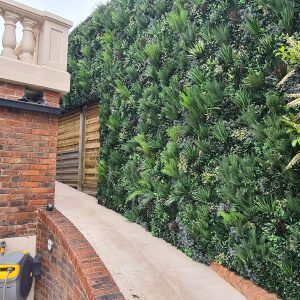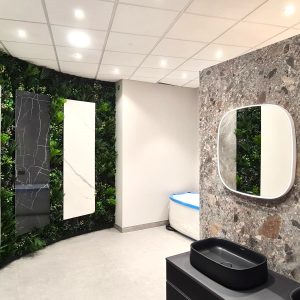Vistafolia Vertical Garden System
Vertical gardens create new green spaces, especially in densely-populated urban environments where both greenery and land are a premium. While widely used as decorative screening for featureless or unattractive walls, the real ingenuity of a vertical garden is its optimised use of space and sunlight. Plants receive more light from a vertical surface, where energy can be absorbed from the side, not just the top, as in horizontal placement. For farming, this growing technique can increase crop yields while managing limited space. However, for creating pleasing green vistas, the resources needed to achieve verdant growth may be too costly. Especially in areas with low natural light, an artificial vertical garden with beautiful, ultra-realistic foliage can be more efficient in providing the luxuriant greenery to brighten up a tired or dull setting.
Strictly speaking, a vertical garden is a system for supporting the growth of plants on a vertical surface for the efficient use of existing space. Increasing agricultural production in urban environments is a prime reason for employing this technique, to grow vegetables, fruits and herbs. Ornamental plant displays are now very popular, for both commercial and residential spaces, and have become synonymous in the public mind with vertical gardens.
Whether fashion or function, living vertical gardens don’t just ‘happen’. The only instant in the process of constructing a vertical garden is probably the idea of putting up one. All the rest is pure hard work, from site assessment to the maintenance needed for the entire life of the vertical garden. A complete understanding of the commitment needed to put up and maintain a living vertical garden is a must before deciding on building one. Similarly, awareness of the benefits of artificial vertical gardens is useful prior to embarking on a living vertical garden project.
How Does Your Garden Grow Up?
Design and growing solutions for living vertical gardens vary, from DIY to sophisticated vertical garden systems involving steel structures with modular panels (or pockets) filled with substrate (growing medium). The growing media can include soil, compost and potting minerals such as perlite and vermiculite. Planting containers can be just about anything – from pots, troughs, sacks, cans, bottles or boxes. Structures range from racks, ladders, tubes, beams or any construction that can support pre-vegetated panels.
Supporting structures for climbers (the ‘easiest’ vertical garden) include pergolas, trellises and latticework, and may be made of metal or net. More sophisticated modular systems are usually composed of stainless steel panels, with a wall frame of wood or stainless steel. Vertical garden systems with flowerpots, meanwhile, feature post and lintel stainless steel technology. Botanist and vertical garden pioneer Patrick Blanc uses a framework with PVC sheet, polypropylene foil and felt, his water-retaining substitute for soil. While lightweight, the necessary circulation mechanism for this structure is a metal frame with pipes (from either aluminum, galvanised or stainless steel) in a rectangular grid design. The PVC panels are attached to the metal pipes to create an aeration gap.
The choice of planting is the third critical aspect of vertical garden design and construction. Before any species can be selected, factors pertaining to wall location and orientation should be studied. Walls that face south are recognised as best for plant growth. The amount of shade and sunlight is critical to the success of the planting scheme, as is the climate and humidity. The rule of thumb is to select plants that survive in a more northern climate than that of the proposed vertical garden’s. Plants chosen should be able to tolerate the wall conditions, do not droop at certain elevations (plants positioned around eight feet or higher will likely droop, smothering the planting underneath, and will have to be trimmed) and can be coaxed to grow in a specific direction.
Just trying to keep these three basic components in mind –structure, growing media, planting — suggests a project of considerable complexity.
Weight Load, Waterproofing and Drainage
There are many other considerations to keep in mind when building a living vertical garden. First of which is the structural integrity of the wall surface to which the frames and planting panels are attached. Accounting for water retention, a vertical garden can weigh as much as 40 pounds per square foot, a considerable load for weakened or old walls. The weight-load capacity of the wall will determine the living wall system that can be sustained (whether modular or fixed frame hydroponics, vertical displays with pots or trays on a frame, trellised system, among others), the planting medium, the planting scheme and the irrigation and system design.
Another important element is waterproofing, to prevent damage to the existing structure caused by moisture and fertiliser salts as well as the formation of moulds. An air gap between the wall surface and the vertical garden system effectively will stop the movement of water between the two structures, but this will eat up additional space for the project. Waterproofing membranes are often employed instead, but care must be taken that these comply with building standards.
Drainage is a very important component for the sustainability of a vertical garden and surrounding environment. Excess water from irrigation can be filtered through the building’s drainage system although more ecologically-minded projects use recycled water. Runoff is a fact whenever water travels down a vertical surface, and must be captured at the base to prevent unsightly and unsafe wet floor surfaces. Improperly drained green walls can damage the vertical garden and the host surface. To guard against waterlogging, some systems control-drip water at prescribed times, with nutrients also added to the water. This can be a complicated, costly mechanism that likewise adds to the weight of the vertical garden.
A closed drainage system, where water is collected and recycled, can have complications, too. Recycled water can easily transmit plant disease, and may need ultra-violet sanitation. The use of greywater (household wastewater, except from toilets) can also cause unpleasant odours and does require a bit more effort than clean water.
Planting Media and Irrigation
The issue of gravity inevitably comes up when considering the choice of planting medium. Obviously, the substrate or planting medium has to be lightweight to take some load off the wall. Planting media should also have high water- and nutrient-retention capacities for the health of the plants, good porosity and a neutral pH.
Each type of growing medium also has disadvantages that cannot be easily overlooked. Loose medium, the soil-in-the-bag type, needs to be replaced at least once a year on exterior placements and at least once every two years on interior vertical gardens. Soil also tends to be lost through the life of the vertical garden, and tending the system can be quite messy. Mat media systems, which are often made of felt mats, are easier to handle but their thin layers mean that certain plant roots will be too active to manage in the long run and will grow out and prevent water flow. The affected mats will then have to be cut out and replaced with new mats. The best alternative, structural media grown in pre-defined blocks, can be used for more than a decade without replacing and are easily handled. However, they are quite expensive to install.
Irrigation is a complex process that has to be executed well for a living vertical garden to thrive. One will have to consider the supply of water, the delivery system, and the interactions between planting media types and water.
Sophisticated, automated systems are employed for large vertical garden projects or those in high-visibility locations. These systems can automatically regulate the volume and frequency of watering, monitor substrate moisture levels, pH and nutrient levels. For hydroponic systems, fertiliser in controlled doses is automatically injected into the irrigation flow. It has to be said that effective handling of such fertigation systems is a specialised skill, as one has to continually monitor and adjust pH levels, water hardness and dissolved salts. Most vertical gardens make use of a sensor-controlled, drip-irrigation mechanism that minimises water use.
Most vertical garden systems also use thin, soilless planting media that is prone to drying out, as the plants have no access to subsurface water, unlike ground plants.
Ventilation, Lighting and Microclimate
For the health of the plants, a vertical garden must have good ventilation, which aids both transpiration and photosynthesis by dissipating moisture. Similarly, interior vertical gardens should be positioned away from drafts of hot or cold air that damage plants. The vertical garden also should not be adjacent to windows and doors, which generate plant-damaging heat and cold radiation.
When natural light levels are low, additional lighting for indoor placements is needed. LEDS, which are long-lasting and create little or no heat, can be quite costly. Using all natural light may require sophisticated equipment such as a special glass with an orange tint that deflects UV rays while allowing full-spectrum light in for photosynthesis.
When creating an external vertical garden, it is very important to analyse minutely the climate conditions that will affect the planting. An understanding of air temperature, wind speed, relative humidity, solar radiation, cloud cover and monthly precipitation will enable optimal plant selection. For example, the amount of sunlight received varies in different geographic zones. London receives relatively low levels of sunshine daily than other locations which can be a boon to plants, as too much solar radiation can be destructive.
The precipitation level in a particular locale, as well as the amount of rainfall, are deciding factors for plant choice as well as how to irrigate. Wind speed also has to be considered. Windswept conditions for roof terrace vertical gardens are a complicating factor. Plants can normally withstand wind speeds of up to 4.4 meters per second.
External Factors
There are also external, environmental considerations that have nothing to do with the vertical garden per se, but closely impact its sustainability or are affected by it.
Vertical gardens generate humidity and water that somehow drips or gets to the surrounding areas and may affect the finishes of the adjacent elements or structures.
Because of the high-maintenance needed to sustain a vertical garden, additional storage space must be allotted for the maintenance equipment, which needs to be on hand for easy access by the maintenance managers. For huge vertical gardens, provisions may include ladders and lift systems to access hard-to-reach areas.
Pruning the plants likewise needs to be undertaken with care and understanding of the needs of the vertical garden system. There should be a balance between plant size and root growth.
Just To Illustrate: A DIY Project
Clearly, a living vertical garden is a huge project that should never be taken up on a whim. Even the simplest, do-it-yourself projects are never easy as factors such as irrigation and lighting are complicated in themselves.
Just to illustrate the amount of effort it takes to create even a simple living vertical garden, here is a DIY guide from Popular Mechanics for a simple vertical garden:
- After choosing a wall, build the frame, a three-layer ‘sandwich’ of frame, plastic sheeting and fabric. It is advisable to construct the entire structure before hanging it on the wall, so it can be easily take down as well. To build a frame, the magazine suggests using a ¾-inch PVC pipe, elbows and four-way joints. It is not recommended to use metal because of the weight, or wood that requires pressure-treating to prevent moisture rot.
- The plastic sheeting is then attached to the frame. The plastic serves as protective layer and backing for the fabric layer, and will also keep water off the wall. It is recommended to use PVC sheets.
- The next step is to attach the fabric layer. The fabric layer is the bedding for the planting, and will hold the water for them. The fabric used for this particular DIY vertical garden is basic felt carpet padding, although the magazine advises that just about any fabric that can retain water without rotting is feasible.
- Two layers of fabric are needed for the vertical garden. They are attached directly to the frame with galvanized screws and stainless-steel staples. Stretch the fabric across the frame, smoothen out for wrinkles and secure.
- The irrigation system will keep plants growing on this vertical surface. The idea is to provide moisture throughout the fabric layer. An irrigation system can be constructed out of poly tubing with fittings that lock. The irrigation system for this set-up is basically a tube placed across the top of the vertical garden panel with emitters from which water drips down. This simple irrigation system can be sourced from an irrigation supplier, where you can also purchase the irrigation drippers and the standard valve.
- A propagation timer also will be needed. The timer should be able to be set in seconds rather than minutes. The ideal irrigation regimen is a quick flow of water three to six times a day for 10 to 15 seconds. An emitter should be attached every two to three inches along the top irrigation tube. This can be adjusted to suit the particular needs of the vertical garden. The key is to find the right balance between keeping the wall wet and overwatering the plants, says the magazine.
- Attach the frame to the wall using stainless-steel hardware. Hooks and brackets screwed into the wall can be used to attach the frame.
- Next, add a fertiliser injector, which has a simple irrigation valve that sends liquid fertiliser into the irrigation system. Install the entire irrigation system and connect to the water source. The water needs to be filtered with an irrigation water filter, which can be bought at most hardware stores.
- To take care of the runoff, plant a flower bed at the base of the vertical garden.
- Choose the planting, taking into consideration climate, microclimate, aesthetic preferences and the load-bearing weight of the host wall.
- To insert the plants into the vertical garden frame, make a horizontal cut into the material with a razor blade. Get as much soil off the plant’s rootball first (to prevent root rot ( then insert into a cut. Insert three to five stainless-steel staples to attach the cloth to the plastic backing in a semi-circle around the root ball.
- If plants that create shade are planted at the top, plants that tolerate shade, such as ferns, should be placed underneath. With real plants the positioning is critical, the planting scheme must be fully thought out.
How many steps did this simple, DIY vertical garden project take?
In marked contrast, a high-performance artificial vertical garden system like Vistafolia is as easy to DIY install as counting from 1 to 3. Each panel can be handily fixed to just about any wall surface using its unique drill-and-cap fixing system that’s as easy as attaching a shelf on the wall. The stainless-steel panels are lightweight and practically put no weight on the host wall. There is no irrigation, lighting, planting medium, fertilisation or pruning needed. The signature panels have overlapping foliage that provides seamless coverage and mimics the natural movement of plants for an incredibly life-like, lush green display that creates a stunning green view for any environment.




